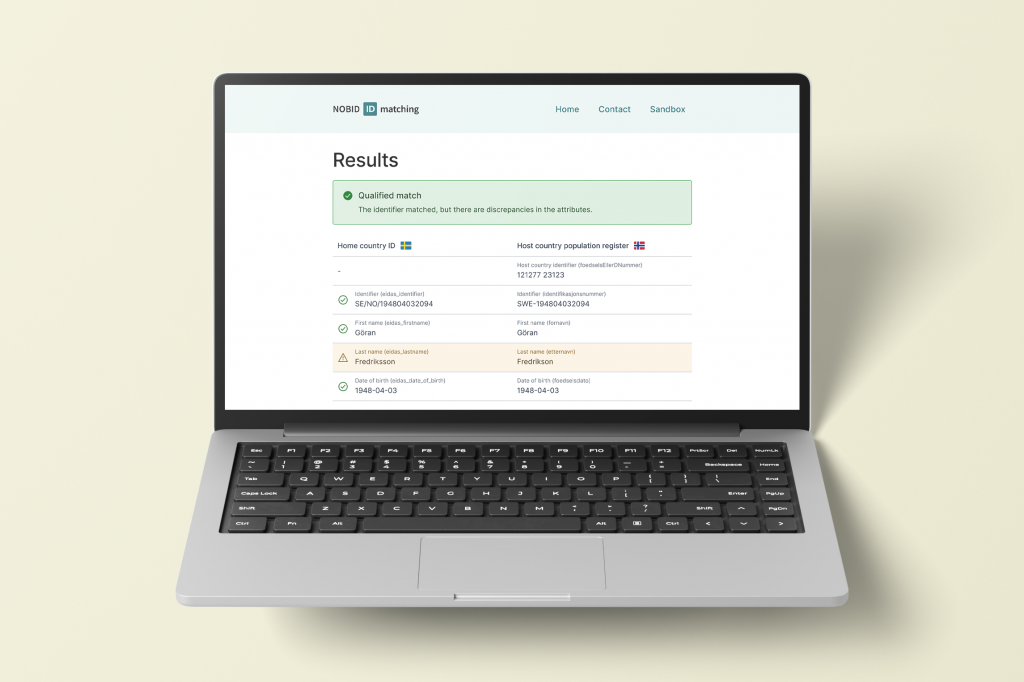Identity Matching
Identity matching (IdM) constitute a fundamental prerequisite for the realization of cross-border access to digital services. On this page, you will find information about what IdM is and what NOBID does to solve IdM in the Nordic-Baltic region.
What is IdM? IdM refers to the process of recognizing and linking a user´s identity across different system or jurisidiction. In a cross-border context, it is about identifying a returning user that wish to access online services in a country that the user previously has been registered.
Whereas the eIDAS regulation sets down common rules for secure and seamless use of digital identities across Europe, including IdM, the Nordic and Baltic countries has been particularly proactive in recognizing the necessity of IdM solutions if cross-border access to services is to be realized.
At the political level, the importance of solving identity matching has been emphasised in joint declarations from both the Nordic and Baltic ministers for digitalisation(2023) and the Nordic Prime Ministers (2024).
IdM is a challenge that needs to be solved in respect of the coming European Digital Identity Wallets and the current eIDAS infrusastructure. Presently, there is a very low volume of successful identity matches across all of Europe and in most cases, attempts to make a match are instead unsuccessful or impossible. Because of this, access to cross-border services remains difficult.
What is NOBID doing to solve IdM?
NOBID has initated multiple endeavours targeting IdM. In 2024, a report on Identity Matching in the Nordic Baltic Region, that presents an as-is analysis of the situation across the countries, was released.
Building on these insights and recieved poltical backing, NOBID initated a Proof-of-concept (PoC) project on identity matching.
The NOBID Identity Matching Project
The aim of the project is to demonstrate how identity matching can be solved in line with the eIDAS regulation. Together with expert from both national digitalisation and population registry authorities, and Kantega AS, the project endeavours to develop a technical PoC of an IdM, self-service, solution that demonstrates real matching outcomes and scenarios between the NOBID countries. The scope of the testing and development include demonstrating solutions for both eIDAS 1.0 and eIDAS 2.0.
To ensure greater success rates in matching processes, the project further aims to consolidate common understanding between the countries regarding what data that must and can be utilized for identity matching. Among else, this include considerations relating to a harmonisation of a Nordic-Baltic eID/PID profile that aligns with eIDAS 1.0 and eIDAS 2.0.
Project deliverables
In Q3, 2025, the project released a live sandbox that enable matching of Swedish users in Norway. The developed self-matching service utilizes real test data which are recorded in the Norwegian test population registry (Tenor), and is integrated with the Swedish connection for eIDAS authentication and with the Norwegian eID hub (ID-porten).
NOBID´s ID Matching sandbox further enable eIDAS login to a fictional online bank with both a wallet solution and via the eIDAS nodes.
The IdM PoC, or sandbox, has been built by Kantega AS, and is accessible here: Self-test of the IdM PoC service
What is next?
The NOBID IdM project will continue into 2026 with a continued aim to test and demonstrate matching solutions. Currently, the IdM sandbox only allows for testing of Swedish users accessing a Norwegian service. Acquisition of additional test data from the other countries and expanding the sandbox to include other NOBID countries, use-cases, and matching outcomes, are therefore upcoming milestones that the project is working towards.
In addition to testing activities, the project will further continue the work stream on what data to be employed in the identity matching processes.

FAQ
A returning user, or returning customer, is someone who has a digital user relationships or legal entitlements in one country but resides in another. Typical examples include:
- Pensioners receiving benefits from a former country of employment
- Students with education from abroad
- Workers with rights and obligations across multiple countries
The goal is to ensure that such individuals can be easily and securely identified when they return to use public services across borders — without needing to register again each time.
Two different solutions are being developed and made available for testing:
- Solution A focuses on integration with national population registers and provides a seamless user experience.
- Solution B is based on a modular technical architecture, with strong emphasis on privacy and data protection.
Both solutions aim for certification under the EU’s eIDAS 2.0 regulation, ensuring compliance with future European digital identity standards.
- Simplify cross-border access to public services
- Ensure secure and efficient recognition of individuals with rights and obligations in multiple countries
- Strengthen European cooperation and contribute to a common digital identity framework
